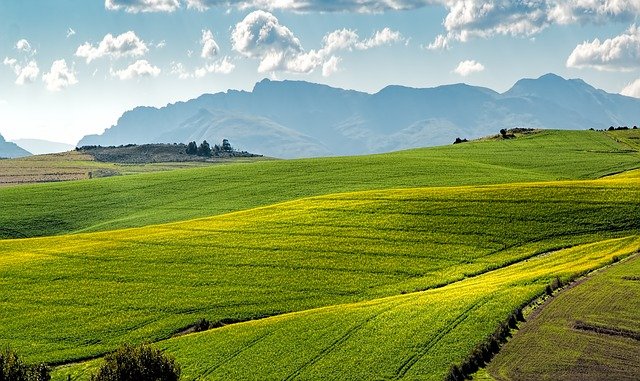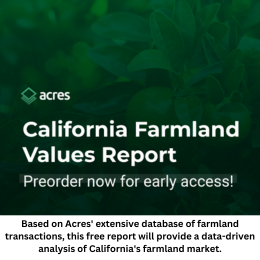April 7, 2021
By Joseph Byrum
When faced with a choice between investing in whatever technology startup is hot these days and what’s essentially a very large patch of dirt, the choice for many is obvious. Shiny beats dirty every time. But maybe that’s not the right way to look at things.
My last article explored how the deflationary impact of technology and the inflationary impulse of the Federal Reserve is creating the worst sort of uncertainty for investors and how farmland represents a tangible asset that’s ideal as a long-term store of value. It’s worth diving more deeply into the topic to understand how we arrived at this point.
The rapid advances that give tech investments their meteoric rise is also what often leads to their fall. All but the lucky few startups are either replaced with a fresh, new entrant to the market, or they’re gobbled up by an established tech giant. Farmland lacks the sizzle of the tech industry, and its growth potential is not obvious on its surface. That, in fact, is part of farmland’s advantage.
Farmland investment is a relatively new phenomenon. From the 1960s through the 1970s, capital asset managers never really consider farmland a viable asset class. In fact, when Continental Illinois Bank expressed its intention to begin investing in 1977, they were quickly shut down. Their idea was to ease a capital crunch that farmers faced with $50 million in investment from pension funds. The Agland Fund would have purchased farms that could be rented for use by operating farmers. Rents would then provide a steady stream of income to investors. Local opposition wanted none of this, with shouts about how such a deal would “destroy family farms.” The cries were heard in Washington, which dispatched local members of Congress and even the Secretary of Agriculture to convince the bank to back down.(1)
It wasn’t until the pioneering work of University of Illinois economist Peter J. Barry appeared in the 1980s that the idea became respectable.(2) The idea has taken off, particularly in the wake of the global financial crisis as the need to diversify became more obvious. The OECD noted in 2010 that farmland investment had become “a small but rapidly growing phenomenon, involving large scale financial institutions, hedge funds and real estate investment trusts” with 54 funds spread around the world.(3)
Not just a hedge against risk, a good deal
The impact of the COVID-19 virus response on the economy can’t be understated, and plans for the future need to be adjusted accordingly. The U.S. Department of Agriculture (USDA) recently re-crunched the numbers and found agriculture’s outlook to be positive. Among other factors the department noted were that crop prices are low and stable, and livestock expansion is likely to make the most of that low feed costs. As an investment option, agriculture continues to check all the important boxes.
Scarcity. Land is scarce, arable land even more so. Some 37 percent of the world’s land mass (nearly 47 million square kilometers) is farmland, ranging between less than 1 percent to more than 80 percent by country.(4) It is also a thin market, as farms have a low rate of turnover in the 1 to 2 percent transfer range, with properties usually transferred between families.(5) In the U.S., available cropland has dropped 3 percent as a percentage of national land since the 1970s,(6) and this trend is expected to continue. Fortunately, technologies like advanced plant breeding, GMOs and new crop protection formulations, we’re able to grow more food to meet the rising demand — and that demand is substantial.
Rising demand. By 2050 there may be some 9.7 billion people on the planet, and they’ll enjoy a rising level of income(7) that ensures we will see greater demand for not just more food, but also higher-quality food. United Nations makes its estimated based on high, medium and low assumptions, which means we’ll see demand for food increase by anywhere from 59 percent on the low side to a doubling at 98 percent at the upper end.(8)
Simple and secret. Farmland sales have a low agency cost than equities, leading to lower transaction costs, and the deals aren’t made public until after they’re entered into land records. This limits the ability of speculators to create bidding wars or snipe prime land.
Primed for growth. Farmland prices are currently in an equilibrium state,(9) with supply and demand matching (both are high currently), but most farms has only just begun implementing advanced data analytics solutions that can optimize farm operations and maximize profits. The smarter the farm, the higher the returns and the lower the risks.
Diversifying farmland’s unique risks
While farmland has unique upsides, this type of asset also comes with downsides that need to be addressed for the best results. Last year, the Midwest derecho battered 14 million of acres of cropland, establishing weather variability as the biggest recurring threat to farmland profit. This risk can be mitigated by spreading investments geographically so that the level of returns average out over time. It’s also best to diversify crop types so that a bad year for corn can be balanced by a good year for soybean. The risk that comes from the annual harvest cycle can be mitigated by investing globally, though this raises risks of its own related to exchange rate and foreign regulatory issues.
Due diligence is critical to success in farmland investment. Every farm is unique. Every field within a farm is its own ecosystem, and that means potential buys require individual analysis. Fortunately, technology has made remote scouting a reality, using satellite imagery backed by data analytics to identify the strengths and weaknesses of every part of every field. Use of technology like this is the best hedge against risk as it allows the investment to maintain an edge over the competition.
That competition is fierce. Argentina and Brazil have become major threats to the long-running dominance of U.S. agriculture, but our fundamentals remain strong. USDA projects record highs for exports of U.S. corn, soybean and cotton by 2030, and the odds of positive, long-term results are very good.
***
Citations:
1- https://www.nytimes.com/1977/03/12/archives/continental-bank-ends-plan-for-fund-to-invest-in-farms-illinois.html
2- Peter J. Barry, “Capital Asset Pricing and Farm Real Estate” American Journal of Agricultural Economics, Vol. 62, No. 3 (August 1980), pages 549-553.
3- https://ideas.repec.org/p/oec/agraaa/33-en.html
4- Agricultural land (% of land area) | Data (worldbank.org)
5- TIAA-CREF (2013) Farmland-Markets-Performance-and-Issues-Center-Draft-public.pdf (illinois.edu) p. 7
6- Spangler, et alia. Past and Current Dynamics of U.S. Agricultural Land Use and Policy Frontiers | Past and Current Dynamics of U.S. Agricultural Land Use and Policy | Sustainable Food Systems (frontiersin.org)
7- Agriculture Analytics Market Growth, Size, share, Trend- Global Industry Analysis, 2019-2025- Meticulous Research (apnews.com)
8- Agriculture Analytics Market Growth, Size, share, Trend- Global Industry Analysis, 2019-2025- Meticulous Research (apnews.com)
9- https://corporatefinanceinstitute.com/resources/knowledge/economics/economic-equilibrium/
ABOUT THE AUTHOR:
Joseph Byrum holds a Ph.D. in quantitative genetics and an MBA from the University of Michigan. He has held executive positions in both agriculture and finance.

Let GAI News inform your engagement in the agriculture sector.
GAI News provides crucial and timely news and insight to help you stay ahead of critical agricultural trends through free delivery of two weekly newsletters, Ag Investing Weekly and AgTech Intel.




